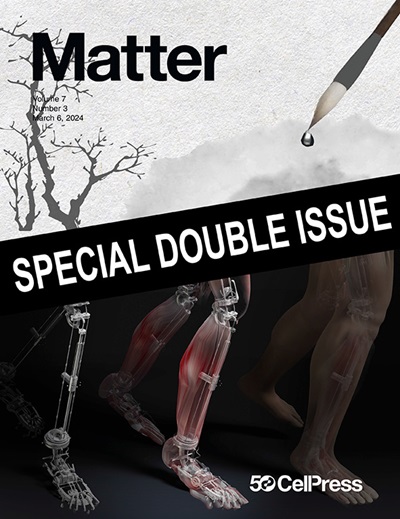Prussene: Transforming ancient pigments into magnetic nanoalloyed 2D layers
IF 17.3
1区 材料科学
Q1 MATERIALS SCIENCE, MULTIDISCIPLINARY
引用次数: 0
Abstract
This study redefines Prussian blue analogs (PBAs), transforming them into Prussene—a two-dimensional (2D) layered nanomaterial—via laser-shock-induced 2D phase transition synthesis (LSPT2D). This scalable nanomanufacturing technique harnesses high-temperature/pressure plasmas to drive phase transitions, converting PBA nanocubes into N-doped carbon nanosheets embedded with ultrafine magnetic nanoalloys. Unlike conventional exfoliation method, LSPT2D enables chemical phase engineering, preserving structural integrity while imparting exceptional properties. Prussene exhibits a high saturation magnetization (108.3 emu/g) and enhanced conductivity due to its conductive carbon matrix. Demonstrating transformative electromagnetic wave absorption, it achieves a reflection loss of −51.7 dB and a 5.87 GHz effective bandwidth across GHz–THz frequencies, surpassing state-of-the-art absorbers. These attributes position Prussene as a breakthrough for stealth technologies and ultrahigh-frequency communications. This work establishes a scalable paradigm for synthesizing chemically modified 2D materials, unlocking applications in catalysis, energy storage, and multifunctional nanoelectronics. Prussene’s innovation lies in its synthesis-process-property triad, heralding a new era in high-performance nanomaterials.

普鲁士:将古代颜料转化为磁性纳米合金二维层
本研究重新定义了普鲁士蓝类似物(PBAs),通过激光冲击诱导的二维相变合成(LSPT2D)将其转化为普鲁士蓝——一种二维(2D)层状纳米材料。这种可扩展的纳米制造技术利用高温/压力等离子体驱动相变,将PBA纳米立方体转化为嵌入超细磁性纳米合金的n掺杂碳纳米片。与传统的剥落方法不同,LSPT2D实现了化学相工程,在保持结构完整性的同时赋予了特殊的性能。普鲁士表现出高饱和磁化强度(108.3 emu/g),并由于其导电碳基体而增强了导电性。它展示了变革性电磁波吸收,在GHz - thz频率范围内实现了- 51.7 dB的反射损耗和5.87 GHz的有效带宽,超过了最先进的吸收器。这些特性使普鲁士成为隐形技术和超高频通信的突破。这项工作为合成化学修饰的二维材料建立了一个可扩展的范例,解锁了在催化,储能和多功能纳米电子学方面的应用。普鲁士的创新在于它的合成-工艺-性能三位一体,预示着高性能纳米材料的新时代。
本文章由计算机程序翻译,如有差异,请以英文原文为准。
求助全文
约1分钟内获得全文
求助全文
来源期刊

Matter
MATERIALS SCIENCE, MULTIDISCIPLINARY-
CiteScore
26.30
自引率
2.60%
发文量
367
期刊介绍:
Matter, a monthly journal affiliated with Cell, spans the broad field of materials science from nano to macro levels,covering fundamentals to applications. Embracing groundbreaking technologies,it includes full-length research articles,reviews, perspectives,previews, opinions, personnel stories, and general editorial content.
Matter aims to be the primary resource for researchers in academia and industry, inspiring the next generation of materials scientists.
 求助内容:
求助内容: 应助结果提醒方式:
应助结果提醒方式:


